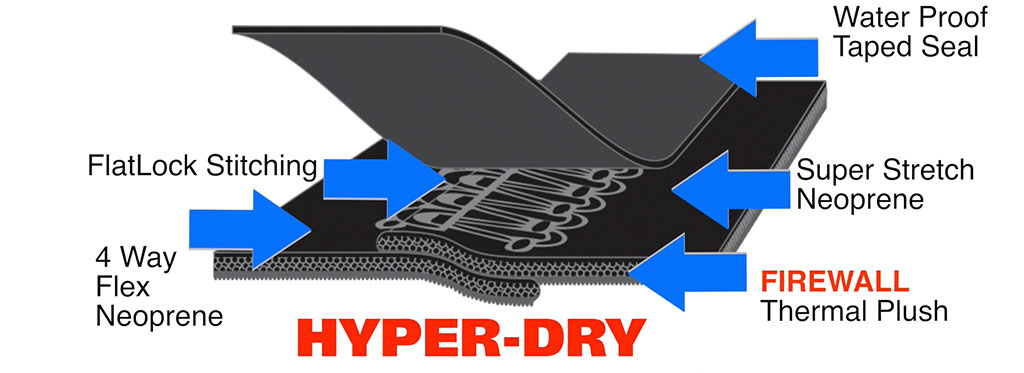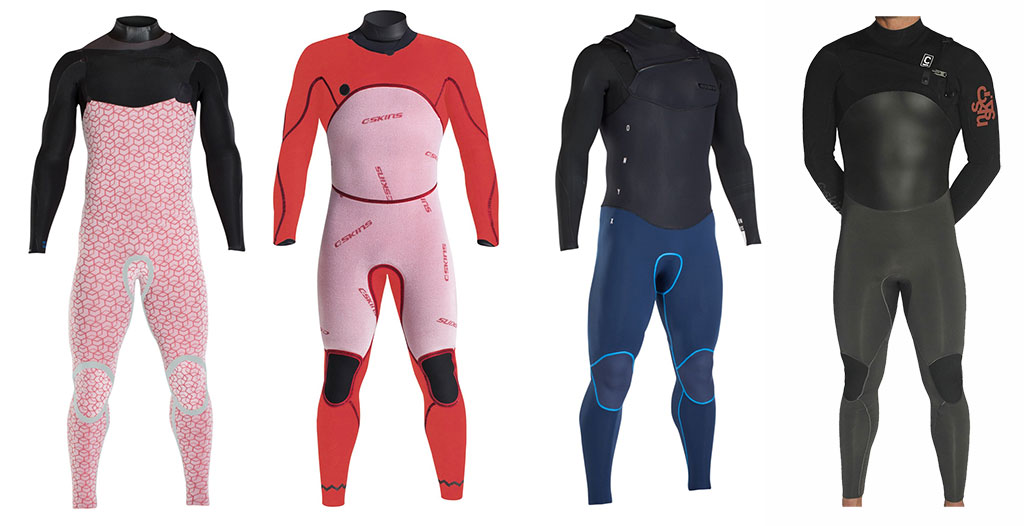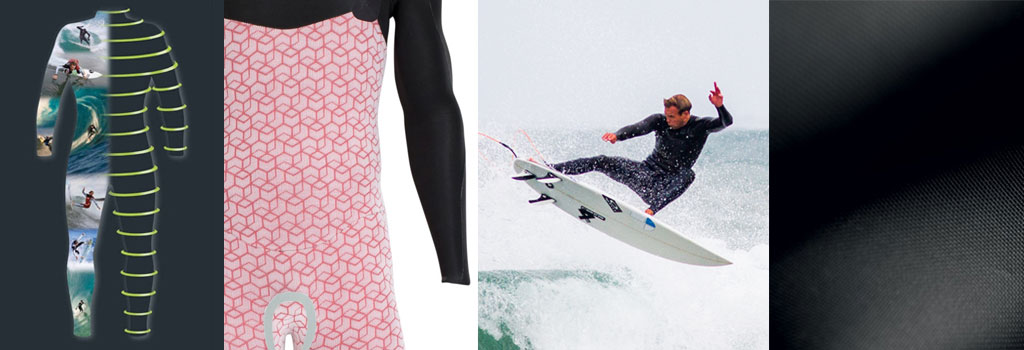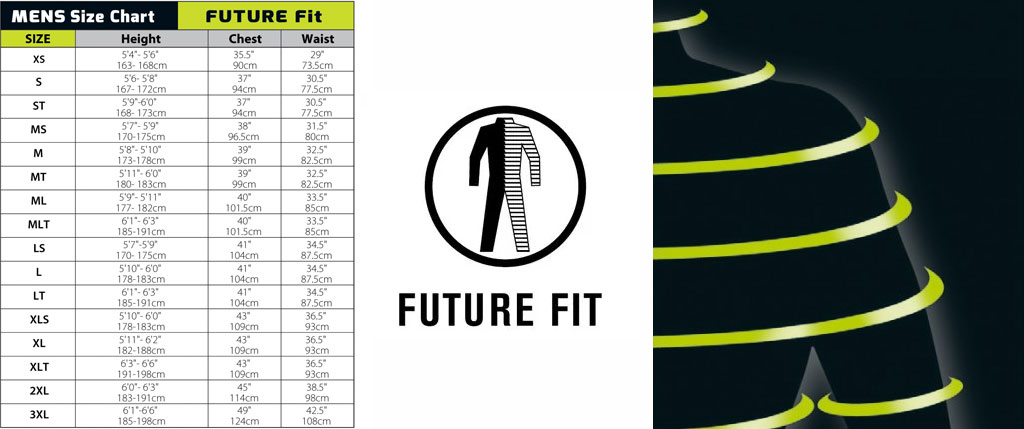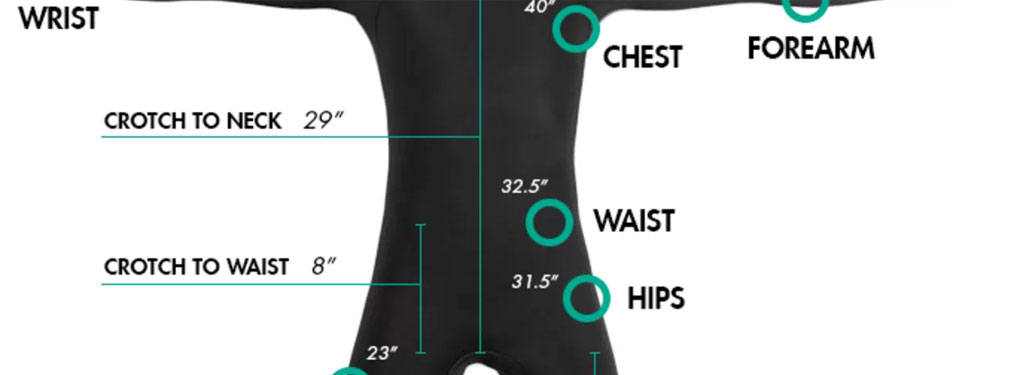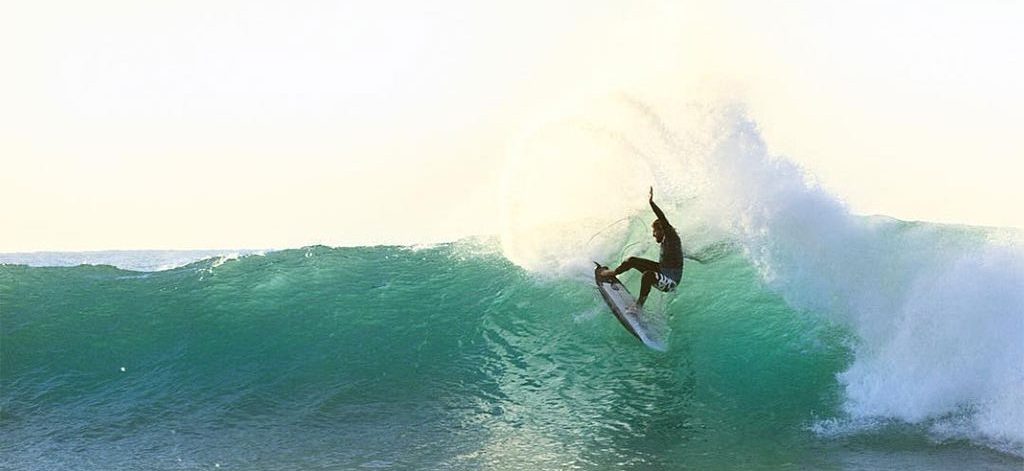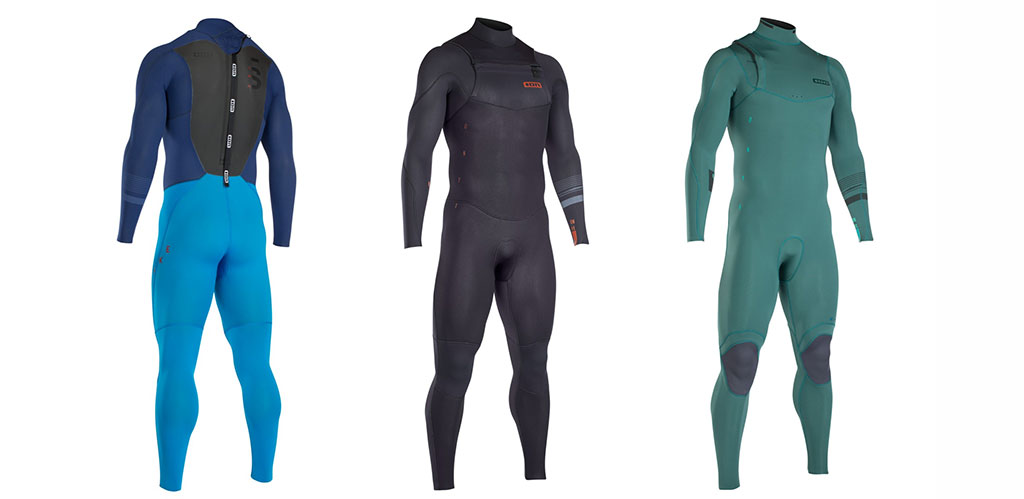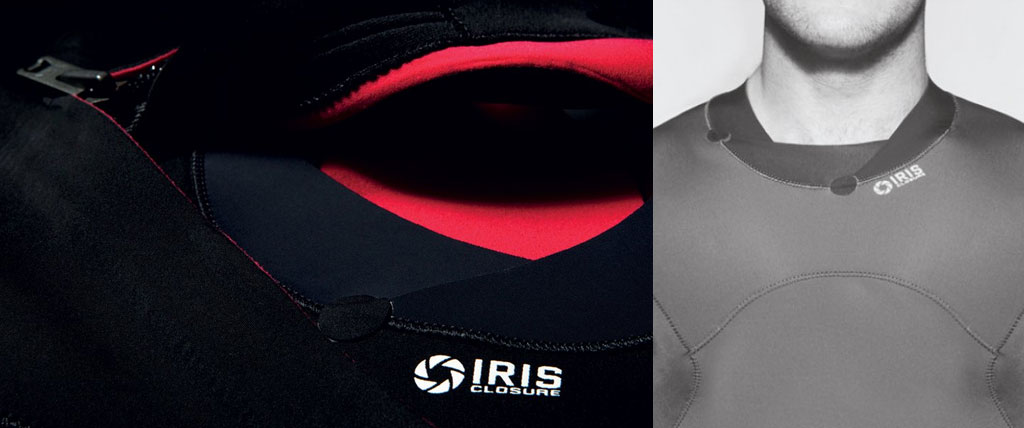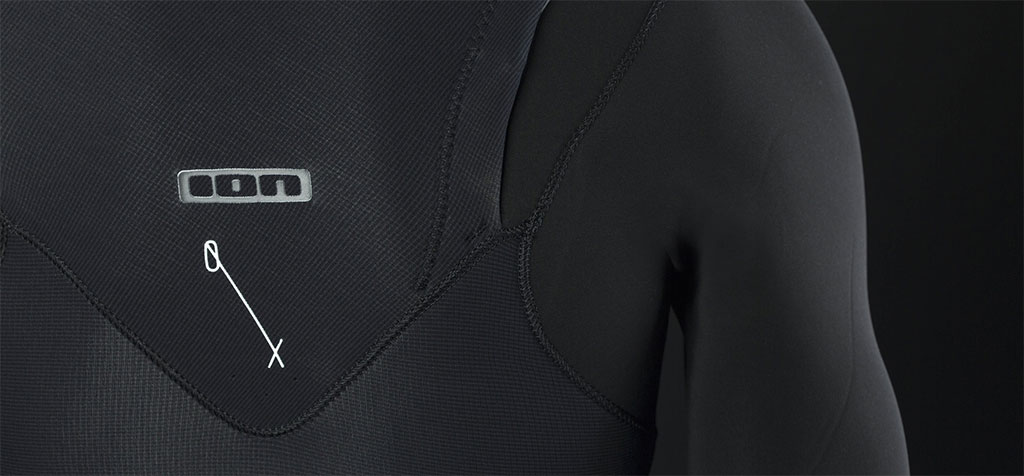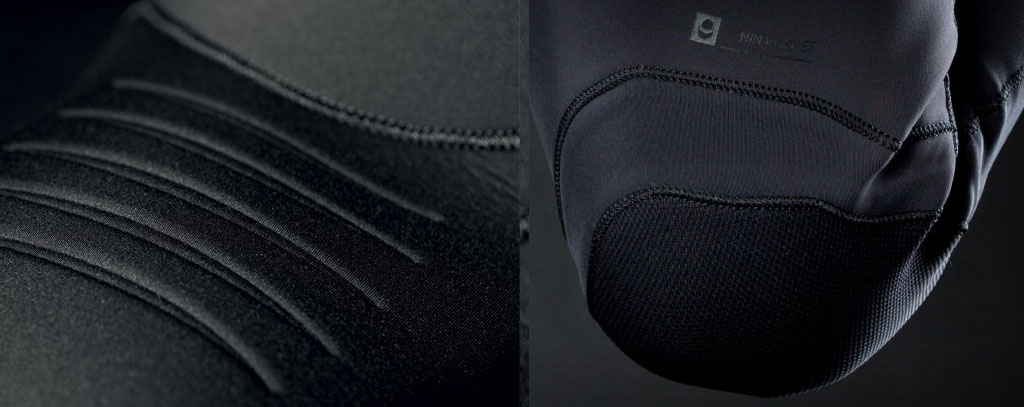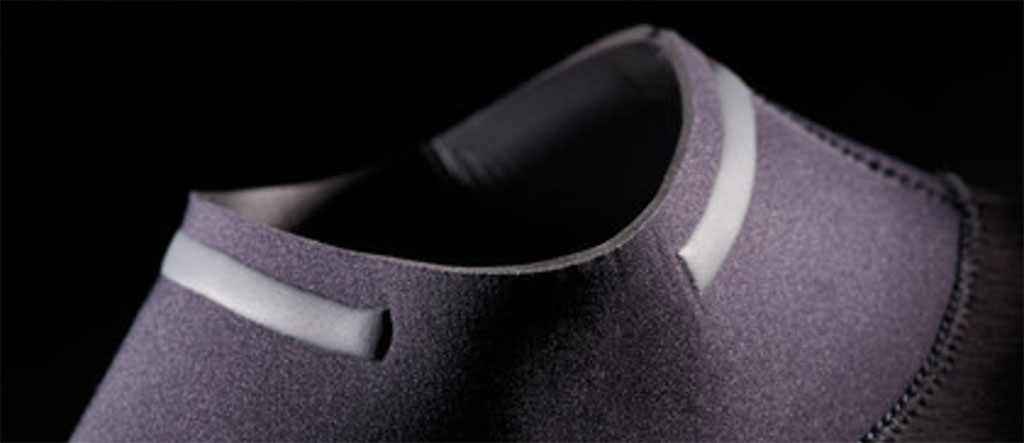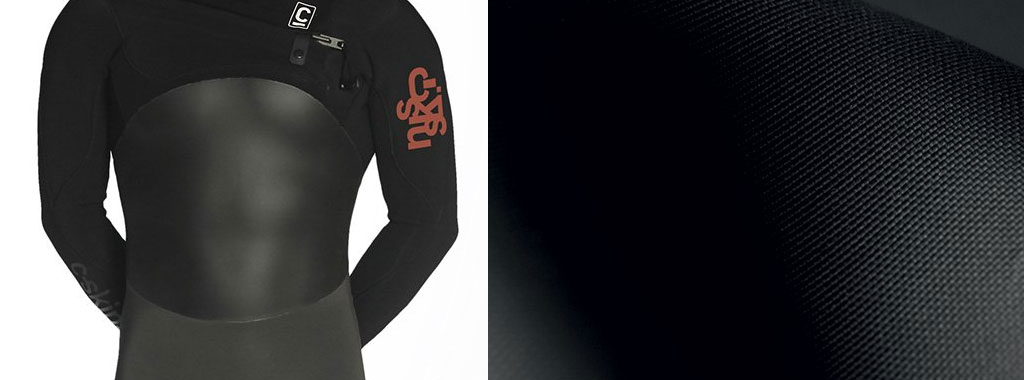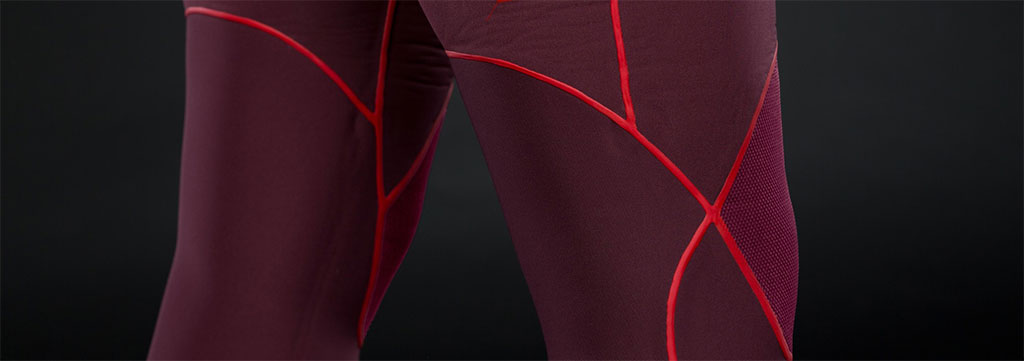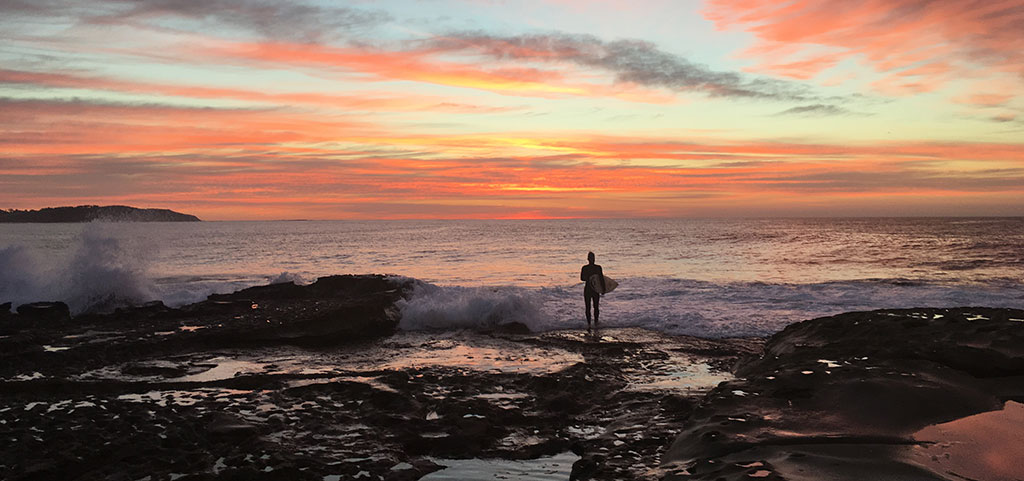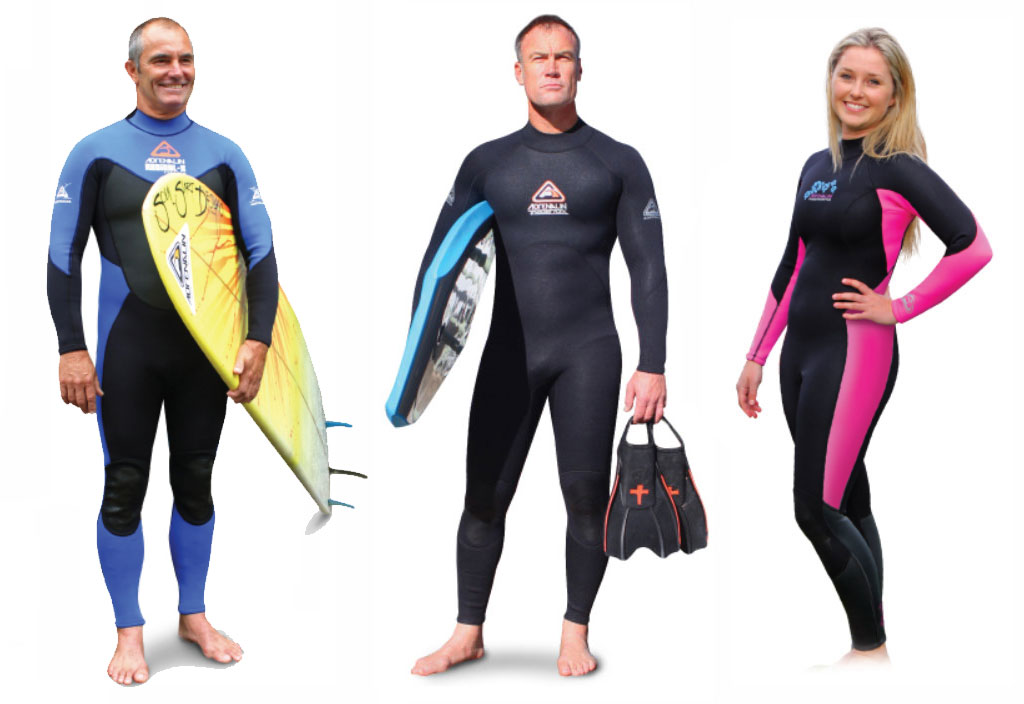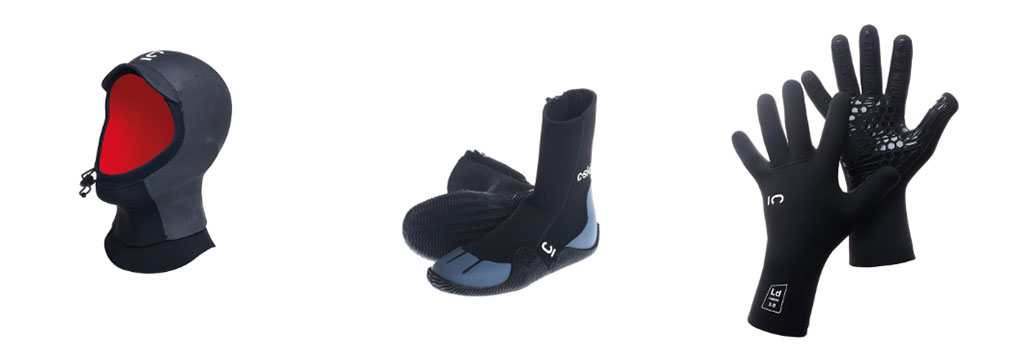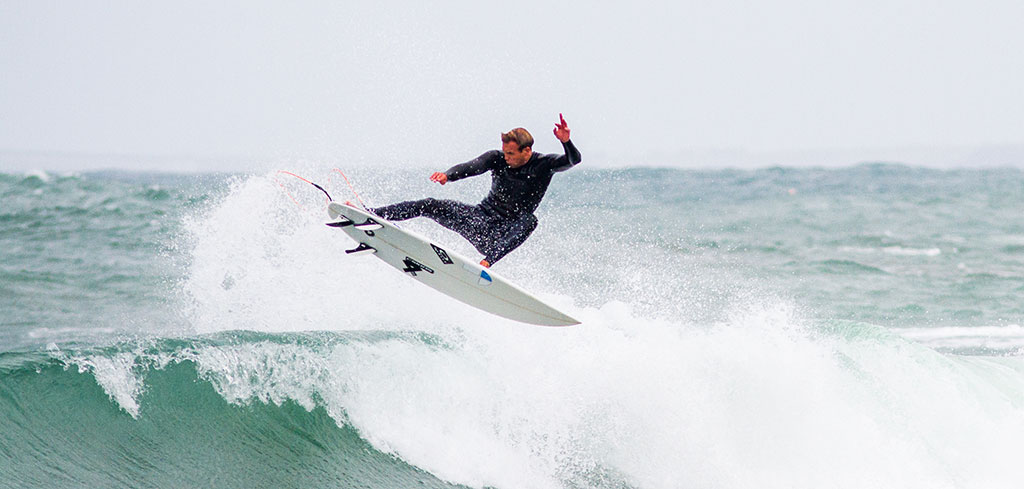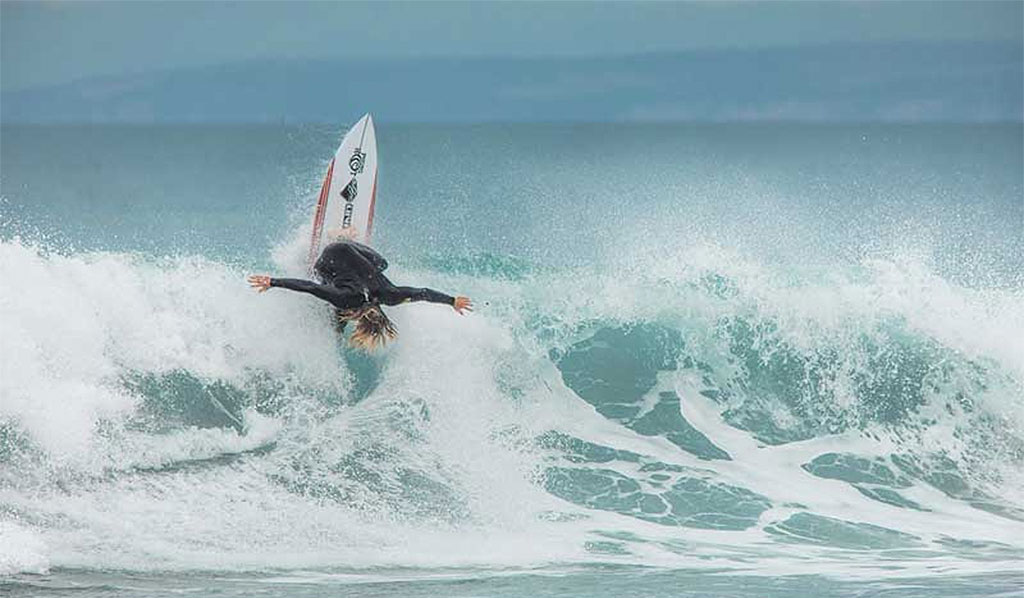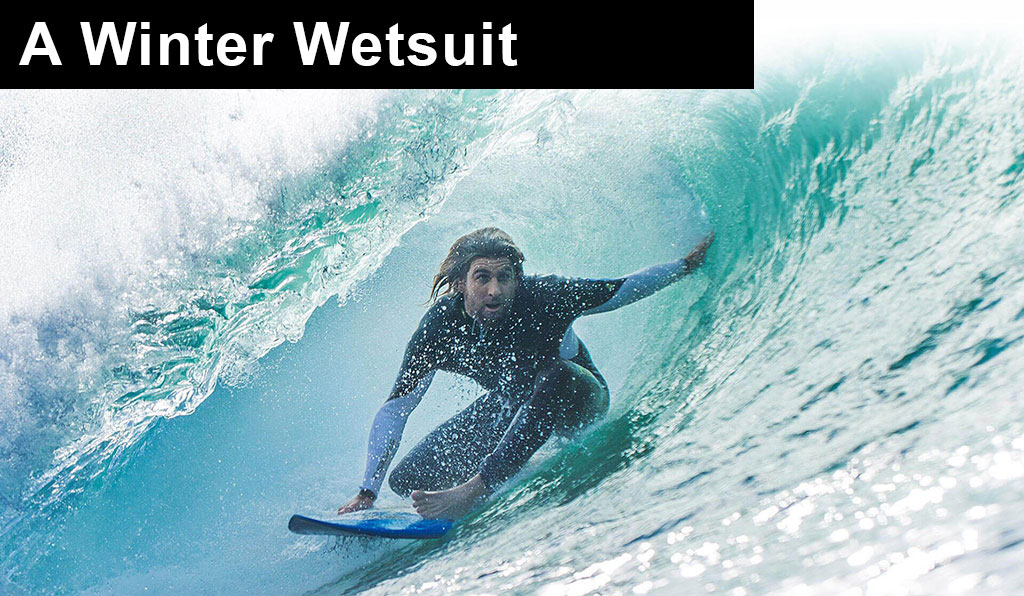
A Winter Wetsuit
A winter wetsuit is one of your most important winter accessories. It’s the key piece of equipment so you can brave the cold and keep surfing. There’s key criteria your wetsuit must have. What are they? Can you prioritise them? How do you know if you’re getting good value?
Let’s look at the characteristics to help you get into the best winter wetsuit.
For 2021
From the outside wetsuit shapes don’t tend to change. This is true for most winter wetsuits. The format of long arms and long legs of the steamer is still standard. Lets look at some of the more impactful changes.
Thicker Neoprene As Standard
These are pics from the C-Skins range. On the left C-Skins actively promote that their wetsuits are thicker. You can see the air bubbles in the middle section that make up the thickness so do not add weight. The middle pic shows updated lining used to capture and maintain your body heat. On the right you can see how C-Skins is progressing their neoprene. A metalised layer is used to reflect heat back to your body while deflecting cold away. Yet the material is still soft, supple and flexible
A continuing trend is toward the use of thicker wetsuits. By thicker it’s a move to wear a 4mm suit over a 3mm suit. There’s likely a mix of reasons for this.
The neoprene used in wetsuits is always advancing. It’s providing greater flexibility along with greater warmth. For example in the past a 4mm suit was not a consideration due to its weight and the effort if required. In your surfing you were heavy making it harder to get to your feet. Your paddling was slower making it harder to get out through the break and to get onto waves. Your surf session was much more fatiguing providing a real disincentive. So if you wanted to surf well, and be able to keep up with the crew, you’d have go for a lighter thinner wetsuit.
Now 4mm suits are much more flexible and light weight. The neoprene is more advanced so it has much more flex. You can move almost as freely as in a 3mm suit. So your paddling and wave catching is almost on par with thin suits. While the 4mm thickness still feels bulkier there’s minimal increase in weight. The neoprene while thicker has more air bubbles providing greater insulation. So the extra thickness is not adding weight. In the case of C-Skins neoprene there’s an ultra thin metalised layer that reflects your body heat back to your body preventing its escape while deflecting the outer cold water and air away. So neoprene has greatly advanced making a thicker suit a warm and high performance option.
Another reason regards the popularity of thicker wetsuits is that as surfers get older there’s a tendency to feel the cold more. Surfers are also wanting to go out earlier and later to get in a surf before of after work when conditions are colder. The 4mm is noticeably warmer than thinner alternatives. As soon as you put it on you feel warm and snug so there’s a psychological incentive factor. In the water the extra thickness through your core and lower body, the area immersed most, is kept warmer. With this area of your body at its optimum temperature, not getting cold, your surfing will be at it’s best enabling explosive high performance moves. Something hard to do without injury if you’re cold.
So if you do surf early or late then going to a 4mm wetsuit is definitely a worthwhile option.
Less Stitching Better Cut
A general trend in 2021 is for wetsuits with less stitching. This means they have less panels. The panels they have are longer covering more area. This impacts your surfing in several ways.
The stitching itself is stiffer than the neoprene material. If you pull your wetsuit where the stitching seam is and pull it where there’s no stitching you will feel a huge difference in flex. So less stitching in the areas where your arms move, at your shoulders and across your shoulder blades, will mean more flex and easier paddling. Your paddle strokes will go farther faster with less energy. Less stitching through the body of your suit means your body movement will be less hindered. Your energy will go more into extensions for big moves and crouches for the tube.
Less stitching also means less wear as stitching is where your suit comes apart. The stitching can unravel or it can tear through the neoprene. Less stitching gives you durability.
One negative of less stitching is that your suit fit may suffer. If your suit uses lower quality neoprene it may feel like a good fit in the shop. However lower quality neoprene tends to lose its shape, it becomes baggy. So your wetsuit will not keep you as warm. The latest neoprene in a good quality wetsuit is designed to overcome this problem. It stretches around your body and with less stitching fits snug. Also special weaves used in the nylon outer prevent the loss of shape.
Better Sealing
In the left image you see stitching. The stitching on the left is the new slightly raised format that joins the neoprene on a wider surface; the stitching on the right is flat lock stitching, nice and flat. On the right image you see tape being used more widely
Sealed seams, with GBS Glued Blind Stitched stitching and taping, have been around for a while. The older GBS provides a benefit in that it does seal seams so inhibiting water entry. However the glue often starts to weaken allowing water to seep in. Also the stitching that only butts the seams together is inherently weak. So just paddling and surfing the stitching strains. Even if the seam is still intact the stitch holes open allowing water entry. Tape greatly helps the sealing however the tape glue likewise deteriorates and allows water to seep in more and more over time.
Adrenalin Wetsuits was one of the first to incorporate their unique world first solution. Super robust flatlock stitching overlaid with special tape on a special four way flex neoprene. You get strong stitching and maximum sealing that lasts, and great surf performance
Now more effective stitching is being used. This stitching overlaps one layer on another rather than using a butt join. The overlap provides two layers of neoprene that’s harder for the water to penetrate. The stitching also holds much more strongly going through two layers. The tape used has improved glues, improved for the environment and for keeping water out. The tape also keeps the interior of the stitching smoother so you don’t get rash. So there’s a move to more durable effective stitching and sealing.
Advanced Smoothie
These images are both of C-Skins wetsuits. On the left you can see the new smoothie material is applied onto the nylon shell of the wetsuit neoprene. On the right the latest neoprene has an external finish that helps retain form so it doesn’t bag out over time
Smoothie panels, on the wetsuit chest and back, give your warmth a boost by deflecting the wind and beating wind chill. There is however a big problem with the traditional smoothie finish. It is extruded directly out of the neoprene. While super soft and supple it has no foundation so is weak and is easy to get a cut or put a finger through. It would also wear from paddling in the area where your ribs would push down on your board deck. A new smoothie material has been developed. It is now applied on the nylon surface that finishes the neoprene. It’s a distinct layer and much more durable. So look for a suit with longer lasting more effective smoothie panels.
In the past being thicker and heavier the neoprene tended to lose its shape. So what was initially a tight fitting suit soon became loose in key areas like your lower back and thighs. The worsening fit would great reduce the ability of your suit to warm the inner layer of water. When you duck dived or got dumped water would get in, slosh around, and stay in your suit bagging it out even more. The latest neoprene has incorporated a special finish into the outer protective nylon so that the material is more resilient, returning to and keeping its shape.
By Definition
Inside and out. On the left are Fleecy internals – High tech body-heat reflective panels. On the right Super flex and Wind resistance panels. A winter wetsuit holds the promise of warmth and great surfing
There’s wetsuits ranging from light vest tops to short-sleeve long-leg steamers. These can be used at other times of the year. Such as early summer mornings or late arvo surfs, blowy windy days, or going into mid-season.
Can you prioritise your wetsuit’s features? What is most important to you where you surf? There’s no doubt you may have different priorities surfing an uncrowded remote locale where warmth is most important, above. Compared to city madness where you need to paddle as fast as you can just to get a wave and flexibility is most important, below
When it’s cold, the air and water temperature dropping, you need a winter steamer. This is a long-arm, long-leg wetsuit. The purpose of a steamer is to keep you surfing warmly when it’s cold. If it’s not cold one of the other wetsuit types can suffice. In winter you want to be able to surf when you want, when the waves are good, regardless of how cold conditions may be.
Prioritise Features?
Winter magic. If you’ve got up early to get a session like this you want to surf your best. So what if you have warmth without flexibility? Flexibility without warmth? How well will you surf if either of these features are lacking in your wetsuit?
There’s key features that make up a wetsuit. It may seem possible to prioritise these.
You could say warmth is most important. However if you’re warm but can’t paddle or get to your feet because your wetsuit is too heavy or stiff, your surfing won’t be much fun. Alternatively if you can paddle fast and are super flexible, but are freezing, your discomfort will ruin your surfing.
So you want a wetsuit that all-round works.
Trade-offs do take place though. When surfing competitively some surfers trade warmth to get flexibility. They may have a lighter or different type suit they use in their competition heat. It’s only around 20 minutes they’re spending in the water. In this way they’re trading warmth for flexibility.
Surfing competitively Professionals do trade warmth for flexibility for their heats. On the left here’s Wade Carmichael. Note his C-Skins Short sleeve steamer. His strategy to wear this more flexible suit in the final paid off. 2nd Place at J-Bay, 2018. Below, Wade in his C-Skins full steamer. Note Filipe Toledo is in a full length steamer so valued keeping warm
Getting a balance of features is most important in your winter wetsuit. Once you’ve got the features closely balanced you can make the end decision to prioritise one. For example you may have only limited time in the mornings so only need to stay warm for a short period. If you’re paddling a lot, a flexier less-warm wetsuit may be okay. But, if you know in advance you’re going to be not-warm, perhaps cool, will you even want to get out for that early?
So what are the key features of the best winter wetsuit?
The Big 4
4 key wetsuit features. Fit. Warmth. Flexibility. Finish. Ideally you want these all at their optimum, all working for you
Fit. Warmth. Flexibility. Finish.
These key features need explanation. It may seem obvious that a thicker wetsuit will give you better insulation, better warmth. However with technology changing rapidly this is not necessarily the case. Warm high tech linings can make a thinner suit as warm as a thick one.
It’s also not just the technology. As with all things surfing, you need the right approach.
Your Fit
The size chart on the left gives an indication of the wide range of sizes and mid-sizes available from some brands, in this case C-Skins. However new fitting techniques such as Future Fit used by C-Skins use computer modelling to go beyond basic numbers to closely match your body shape
The first thing to approach is fit. Your suit has to fit you and fit you well. The way a wetsuit works is to allow a thin layer of water, between your body and your suit, to be warmed. With the right fit this warm water will stay with you through paddling out, duck dives and riding waves. This mechanism can keep you warm for the duration of your surf. If water is constantly moving through your suit, due to a loose poor fit, that moving water will take your body heat away.
So when you’re trying your suit on in the shop it should be very snug, tight. Having a little struggle getting it on isn’t bad. If you’re hot in the suit in the shop this is normally a good sign you’ll be warm in the water. Once in cold winter water your body will shrink a little so your suit will loosen up.
If your suit is too big you’ll have water flushing in and out, greatly reducing your warmth if you get warm at all. If it’s loose you’ll also have chaffing and rashing. Alternatively if your suit is too small you won’t be able to get into it. So it’s about getting your fit right, perfect if possible.
Wetsuits come in incremental sizes. So some brands will have a size Medium, then a Medium Small and a Medium Tall. They often have this for all the main sizes from Small to Large. There’s a size for stocky, thick in the middle, and tall skinny body shapes. So there’s no reason to not get your size and fit right. If it’s not in the shop it can be ordered in for you.
Try It On
It’s important to try your suit on to determine best fit. Why? There’s important measurements that reflect the cut of your suit that aren’t covered in size charts. Measurements like crotch-to-neck make a big difference to the warmth of vital areas like your lower back. You can only find this fit by trying the suit on
It’s important to try the suit on as different brands also have different cuts with fit implications. For example C-Skins and Quiksilver are longer in the body than say Rip Curl and ION. What this means is while the C-Skins will fit snug into your lower back, a Rip Curl might stretch across it. This may not sound like a big issue but this gap created at your lower back will quickly chill.
With the fit around your neck, most suits have a super flexi panel so they’ll all fit fine. Some suits have a smooth glide skin making your neck even more comfortable. With your arm and leg fit it’s in fact better if your suit is a little long as at your wrists you can really feel the cold. If your suit fits your body great but is long in the arms or legs you can always fold the extra length under. Or try a mid size like a MS or LS, Medium Short or Large Short.
If you’re wanting the best winter wetsuit getting fit right is the first place to start.
Warmth & Flex
Latest tech, with body heat panels, gives you warmth normally associated with thicker neoprene in a thinner performance oriented suit
It used to be said that a thicker wetsuit would be warmer. This is still true in the same model, so a 4-3mm thick Hot_Wired will be warmer than a 3-2mm Hot_Wired. Comparing across suit brands though is not so straight forward.
There are different quality and technology neoprene and linings used. So you can’t just rely on the numbers like 3-2mm, 4-3mm. Let’s look at the neoprene.
Neoprene
An air infusion gives insulation and makes your suit thicker. In addition C-Skins go a big step beyond incorporating special linings in their suits to reflect the cold out and the warmth in
Neoprene, referred to sometimes as ‘rubber’ is a type of foam infused with air bubbles. It’s waterproof and provides insulation. This makes up the material of your suit. High quality neoprene gives a number of benefits including warmth, flexibility, durability and low weight. The quality of the neoprene is what often determines the cost of your suit.
Air bubbles can increase the insulation and thickness of your suit without increasing weight. So you can have a thicker suit that is warmer, without extra weight. C-Skins point out that it measures its neoprene thickness to not include the lining of their suits. So in appearance the C-Skins 2-2mm looks like a 3-2mm of another brand though it’s lighter and flexier giving great warmth.
The quality of the neoprene is important too. If high quality it will be supple and sculpt to your body aiding your fit adding to your warmth.
You can normally feel the quality of neoprene for yourself. It will be spongie when you squeeze it between your fingers. It will stretch and be resilient. For example it should stretch to at least double length, then recoil, instantly. If you’ve got different brands side by side you can normally easily discern differences in the quality of the neoprene.
With a brand name suit one thing you should be getting is quality neoprene.
Lining
Various types of plush linings are designed to capture body heat
Many wetsuits today talk about their linings. There’s a lot of hype and imagery around quick dry and body-heat panels. The internal panels often use colours to convey heat and warmth. These new tech linings can be fleeced or fine ridged. They’re plush and they do add to the warmth and comfort of your suit. They add warmth as they provide an area where the trapped water can rapidly be heated by your body heat.
The bushiness or fleeciness of the lining does not necessarily equate to extra warmth. In fact a low pile like a corduroy is proven to work great while some thicker linings aren’t as effective as no lining. Quick dry linings may not equate to warmth. You need water in your suit to warm. If it quick dries while you’re surfing you’re left with just the external cold water pressing against your neoprene against your skin. This becomes uncomfortable quickly.
Reputable brands tend to have linings that work. But even so be aware of the ‘latest thing’. Having no lining, just the neoprene without any fleece as on a value suit, can still work great. Tried and proven technologies tend to give the best result.
Flex
Throwing big moves. Your wetsuit should be a help, itself being flexible, keeping you warm and flexible, and able to perform
Your movement in the suit is vital. If you are warm but find it exhausting to move your arms and paddle you won’t be able to catch waves. Similarly if you’re feeling so bulky that you can’t get your legs under you or bend your back or knees, you won’t be able to surf.
The flexibility and stretch of your suit directly affects your surfing performance.
The quality of the neoprene plays a big factor. So feel and compare the neoprene between suits. As mentioned above quality neoprene gives more flex. Flex also equates to ease of paddling so directly impacts wave catching. It also gives you freedom of movement so you can do big moves when surfing.
To provide value, lower range suits will give you less flex neoprene in the body of your suit while the underarms or entire arms and shoulders may be super flex. This mix and match works well if you’re on a budget. You get warmth in your main and lower body and performance flex in your arms and upper body.
Zip-status and the stitching and cut of your suit panels are also important to consider.
Zip or No Zip
Back zip, on the left, is the go-to option for surfers who can’t get their shoulders into other suits. The Back Zip also seems to be the catch-all for other fit problems, like being solid in the middle. Next, the Front Zip, if done well gives great flex and ease of entry and exit. Zipless, on the right, is said to be the best of all suits for performance as there’s no zip to inhibit paddling or flex for big moves
Wetsuits come in three zip configurations. Back zip, front zip and zipless. Zip status impacts your flexibility, hence performance. In the past zips used to let in water but the latest suits not only have close sealed zipper teeth, they also have barriers behind the zip limiting water entry.
Zipperless suits give great freedom of movement, possibly the best. This is because there’s only neoprene and stitching in your suit. There’s no hard inflexible plastic zip anywhere to impede paddling or surfing moves.
A chest zip can be almost as good depending on the way the zip is implemented. If it’s lean it can be unnoticeable. If it’s bulky or poorly integrated each paddle stroke can feel like you’re pulling against it.
A back zip is considered least performance oriented for your surfing. This is because there’s a long strip of plastic running down your back. When you go into a surfing move where you crouch, bend or extend you can feel the zip limiting that movement. Also with some back zips you can feel constraint in your paddling, the zip limiting the flex and stroke movement between your back shoulders.
Extra Protection – Neck & Chest
A great feature offering extra protection from the cold is the special Iris neck underneath the neck of C-Skins front zip and zipless suits. It provides a great fit for any neck size and creates an area of noticeable additional comfort and warmth
The way the under-zip area is implemented can aid your overall suit performance for front zip and zipless suits. When you’re down on your board paddling your neck and upper chest area is faced with a constant flow of cold water. The second layer closest around your neck, if implemented well, can provide an additional barrier against water entry and can greatly increase your overall comfort and warmth.
This is one of the features to check in store. When the suit is on, without the outer neck flap over your head, does the cut below your neck sit low? If yes this can create problems allowing water to flush in when paddling and duck diving.
Extra Protection – Back Zip
A batwing is a feature of back zip suits. It’s a fine 1-2mm panel that stretches behind your zip. In the image on the right it’s the blue panel. It stretches enough so you can step into your suit. Then when zipped it provides a barrier behind your zip. Water still enters through the zip but it doesn’t get through to your body
Some surfers find the zipperless and chest zip suits difficult to enter and exit. Especially getting the suit up over their shoulders. So traditional back zip suits give a great alternative. The back zip isn’t that flexible as you have plastic running down your back in the place of soft neoprene. The zip can also let in water. Most high end back zip suits include a batwing, a flap that effectively stretches and seals across the zip opening. This does add bulk. However if you can’t get into another style suit a back zip with a batwing is still a worthy option.
Other Features
This is a view of a suit back showing that the stitching is not horizontal. Note it curves down into the middle back. This curve, ION call a Sweep_Cut, provides additional fit and flex. The curved stitching stretches out with each arm movement aiding paddling
Knee treatments, at both the back and front of the knee are specially designed to aid flexibility
The cut of the panels, directly related to stitching, also plays a part in flexibility. Having less panels, and keeping them long, aids flex and your performance. This is because stitching, that comes from more panel pieces, stretches less than the neoprene. So less panels equals less stitching that equates to more flex and greater performance.
Having more panels, and stitching, used to equate to better fit. So you would have a panel to go into your lower back, one under your arm, another over the top of your shoulder. Now with the latest tech like Future Fit the suit forms to your body. This allows panels and stitching to be reduced.
So in terms of maximising flex a suit that has less stitching and utilises a fit-technology is the best way to go.
Another new feature is sanitizing. This is a treatment that prevents the appearance of unwanted odours
The Seal_Tite finish, here shown around the neck, is also used on internal wrists and ankles, This liquid seam material is added to prevent those areas riding up and inhibits water entry
External Finish
The smoothie finish over the abdomen and chest. C-Skins’ implementation is a fine mesh that protects against wind chill while being durable
There’s two main finishes in wetsuits. One is called smoothie. The other is just normal. A normal suit has the same neoprene finish, a nylon layer, over the exterior of the suit. A smoothie suit has parts of the wetsuit, mainly front and back chest, finished smooth. This smoothie area reduces the affect of wind and wind chill. Smooth finished it doesn’t take on any water so it doesn’t get water logged. When the wind blows there’s no extra evaporation creating a chill.
Liquid seams provide additional external seam sealing. They do add warmth but also reduce the stretch of the neoprene
Another type of smooth finish is for seams. Rather than use an external tape, similar to that used internally, a liquid seam is used. This further seals GBS seams greatly limiting water entry. A trade off is that the liquid seam does not offer as much flex as neoprene so it does reduce performance. This isn’t noticeable in your lower body where the liquid seam is most used. In the upper body it can limit performance. So liquid seams tend to be used less in the upper body of performance suits.
It All Comes Together
It’s only by trying on a suit, several suits, that you will get an idea of how it all comes together, how you’ll feel on the water before the sun rises
If you try on an ION suit you will feel how supple the neoprene is. It glides on and fits you like a second skin. You get great flexibility, hence performance. As you move your arms you can feel the ION paddling flexibility. Bending down going through the surfing motions there’s no constraint. It’s got a great high tech lining. In the high end suits you get GBS, taping and liquid seams. So water entry is minimal.
With C-Skins the suit is more substantial. It’s like you’ve got protection. When the air is crackling cold pre-dawn, your body is warm, snug. Once in the water you are even warmer as the trapped water layer heats up. You may feel a little heavier but you can happily wait for waves, wait for the best wave.
For fit, ION has quality form fitting neoprene with a short cut in the body. C-Skins use Bio Fit so give you a great all-round fit.
So if you want to trade for performance, the ION may be your choice giving you easier paddling. If you want to trade for warmth, C-Skins may be your choice. Both suits have great team riders demonstrating every surfing move. So both work great.
Multi Australian Longboard Champion Jason Livingstone, on the left, wears Adrenalin. Highlight colours help identify the super flex neoprene panels. Primarily on the arms, shoulders and side panels. The other panels give less flex and more warmth. Adrenalin suits are great value
Alternatively there’s Adrenalin. Their suits tick all the boxes with features. They are also extremely good value. They use high flex neoprene where it counts on your shoulders and underarms for paddling performance. The body panels use thicker less flexible neoprene. So you get warmth where needed. If you’re on a budget give Adrenalin a look.
Accessories
Accessories can give you more protection if needed. The hood is a personal preference. Booties are more popular. Gloves not so much
Depending just how cold it gets where you surf you can look at accessories. Most surfers though find any accessories problematic. For example the hood limits hearing, in fact it can create a noise in your ears. It can also limit vision. Some booties offer only marginal grip and become stiff in the water. You don’t want a slippery boot, nor one rashing your toes. Gloves need to give good grip and fit snug at your wrist under your wetsuit. You don’t want these filling with water as it creates a problem having to empty them.
So don’t just grab and accessory on the way out. Scrutinise them, give them a good check.
A Winter Wetsuit
Fit. Warmth. Flexibility. Finish. Now you now what to look for, get out and start trying on a few different suits. Do they all feel the same? Hone in on what you like, what feels good. While you may think getting a suit with all the features will guarantee warmth and good surfing, it won’t. Start with your fit. Once you’ve got your fit right, next look at the other key features. If it’s hard to decide, check how hot you feel when you’re trying the suit on. This is a good indicator that the suit will be warm for you in the surf too. Next crouch down, twist, swing your arms in a paddling motion. The flex you feel will also equate to your performance in the surf.



